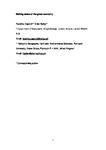Making sense of the green economy
| dc.contributor.author | Caprotti, F | |
| dc.contributor.author | Bailey, I | |
| dc.date.accessioned | 2016-10-13T09:30:05Z | |
| dc.date.available | 2016-10-13T09:30:05Z | |
| dc.date.issued | 2014-09 | |
| dc.identifier.issn | 0435-3684 | |
| dc.identifier.issn | 1468-0467 | |
| dc.identifier.uri | http://hdl.handle.net/10026.1/6514 | |
| dc.description.abstract |
This special issue editorial explores potential research interfaces between human geography and the rapidly unfolding concept and practices of the "green economy". The article outlines a range of critical issues about the green economy that are particularly pertinent and suited to geographical analysis. The first concerns questions around the construction of the green economy concept and critical questioning of current, largely hegemonic neoliberal, growth-focused and technocentric definitions of the green economy. The second broaches the spatial complexities of green economic transitions, while the third discusses the need for critical appraisal of the logics and mechanisms of governance and transition that see the green economy as a key mechanism for economic, social and environmental change. The fourth focuses on the crucial issue of micro-level and individual practices and behaviour, and on links between individual behaviour and wider economic-environmental governance and economic systems. Finally, the article discusses the need for scholars to engage in imaginative consideration of alternatives to current, growth-focused paradigms and conceptualizations of the green economy. | |
| dc.format.extent | 195-200 | |
| dc.language | en | |
| dc.language.iso | en | |
| dc.publisher | Informa UK Limited | |
| dc.subject | green economy | |
| dc.subject | green growth | |
| dc.subject | scale | |
| dc.subject | governance | |
| dc.subject | transition | |
| dc.subject | alternatives | |
| dc.title | Making sense of the green economy | |
| dc.type | journal-article | |
| dc.type | Article | |
| plymouth.author-url | https://www.webofscience.com/api/gateway?GWVersion=2&SrcApp=PARTNER_APP&SrcAuth=LinksAMR&KeyUT=WOS:000344233600001&DestLinkType=FullRecord&DestApp=ALL_WOS&UsrCustomerID=11bb513d99f797142bcfeffcc58ea008 | |
| plymouth.issue | 3 | |
| plymouth.volume | 96 | |
| plymouth.publication-status | Published | |
| plymouth.journal | Geografiska Annaler: Series B, Human Geography | |
| dc.identifier.doi | 10.1111/geob.12045 | |
| plymouth.organisational-group | /Plymouth | |
| plymouth.organisational-group | /Plymouth/Faculty of Science and Engineering | |
| plymouth.organisational-group | /Plymouth/Faculty of Science and Engineering/School of Geography, Earth and Environmental Sciences | |
| plymouth.organisational-group | /Plymouth/REF 2021 Researchers by UoA | |
| plymouth.organisational-group | /Plymouth/REF 2021 Researchers by UoA/UoA14 Geography and Environmental Studies | |
| plymouth.organisational-group | /Plymouth/Users by role | |
| plymouth.organisational-group | /Plymouth/Users by role/Academics | |
| dc.identifier.eissn | 1468-0467 | |
| dc.rights.embargoperiod | Not known | |
| rioxxterms.versionofrecord | 10.1111/geob.12045 | |
| rioxxterms.licenseref.uri | http://www.rioxx.net/licenses/all-rights-reserved | |
| rioxxterms.type | Journal Article/Review |


